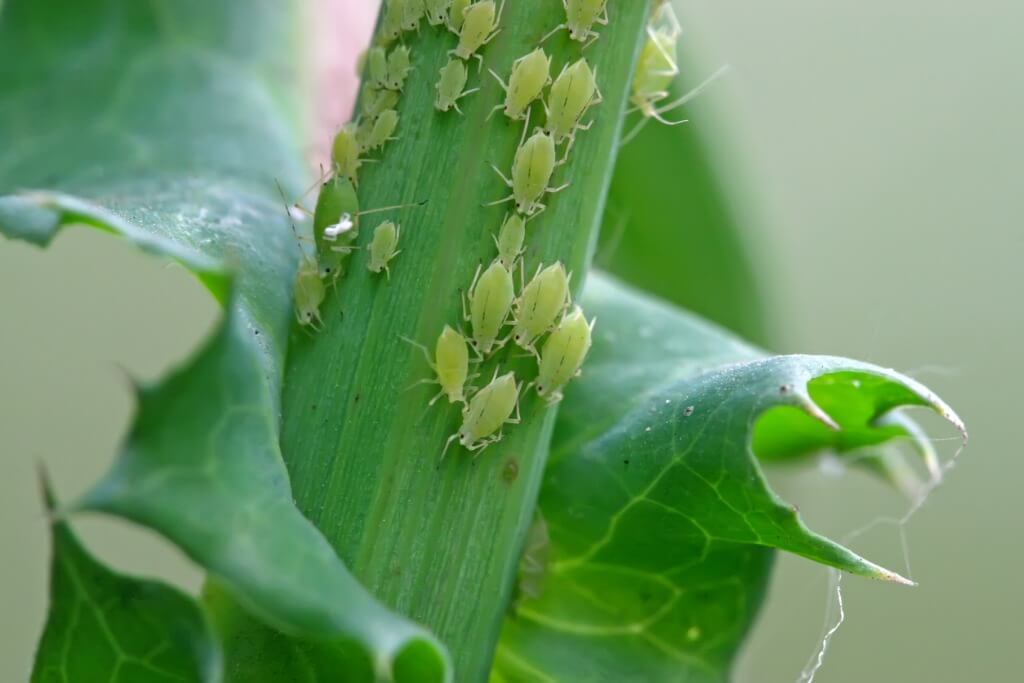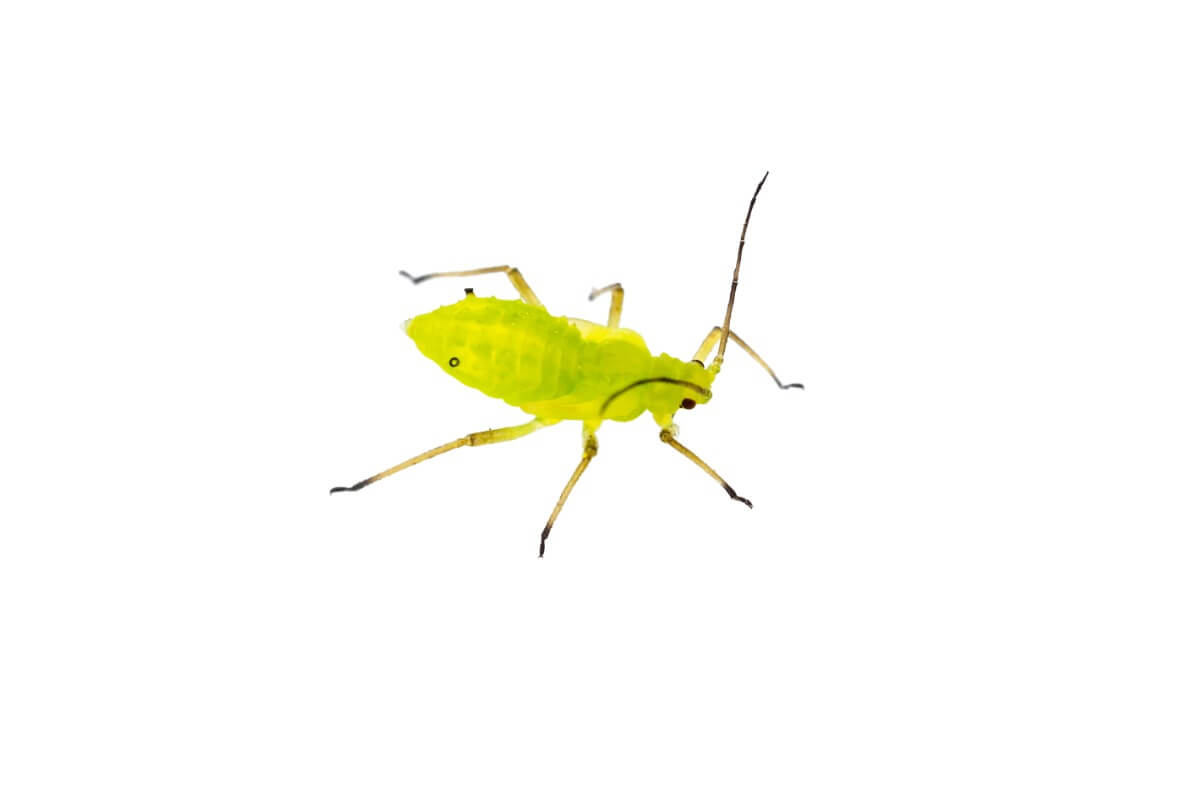The Life Cycle of Aphids


Written and verified by the biologist Cesar Paul Gonzalez Gonzalez
Aphids are insects famous for their phytophagous activity, with which they are able to damage a wide variety of crops. These organisms are capable of decreasing the efficiency of different plantations, which is why they’re often seen as a dangerous pest for agriculture. In fact, one of the reasons behind the destructive capacity of aphids is their complex life cycle.
Read on to learn about the life cycle of these tiny invertebrates.
What do aphids look like?
Aphids vary in size, but are no larger than 5 millimeters in length, so they’re almost unnoticeable invaders. Aphid bodies are oval in shape and soft in appearance and have 2 antennae, 3 pairs of legs, and a pair of wings (but not always). However, they don’t have the typical anatomical division of the insect group (well-defined head, thorax, and abdomen).
The mouth of aphids is of the stinging-sucking type and serves to suck the sap from plants. They feed on the nutrients produced by their hosts (plants), which is why they desiccate and cause the leaves to decay. In addition, aphids are also considered vectors of some viruses, so they cause more problems by infecting crops with dangerous diseases.
The sap that these insects feed on contains a lot of sugars, so they need to process and transform the excess. To do this, they have structures at the end of their abdomen called siphons, which help them produce a sweet substance called honeydew. In this way, they eliminate the excess sugar, thus helping them to interact with other insects (such as ants).
The great ability of aphids to invade and damage crops is due to their reproductive ability. This characteristic allows them to switch from sexual to asexual reproduction, so they can colonize a host in just a few days. Thanks to this, the aphid life cycle is the secret behind their efficient phytophagous life.

The aphid life cycle.
In general, the aphid life cycle can be classified into two types: holocyclic and anholocyclic. The difference between each lies in the reproductive technique they use, but both are focused on improving the survival of the species on its host.
The roles of each aphid in the population
Aphids alternate between sexual and asexual reproduction to cope with the different seasons throughout the year. With this approach, populations can be divided as follows:
- Foundress (viviparous) females: Their appearance is the same as that of any aphid, only with the ability to reproduce without needing to be fertilized. This type of female represents the invasive phase of the species, since it’s parthenogenetic and easily approaches the host. The offspring of the founder are viviparous females like her, only smaller and with reduced fecundity.
- Sexuapara females (oviparous): After a few generations, the founder’s daughters begin to produce winged females called sexuaparas, which are capable of laying eggs. The offspring of this kind of aphid can be either male or female, which is the step that makes sexual reproduction of the species possible. The sexually active females appear only in autumn.
- Females (oviparous): These individuals constitute the sexual phase of the aphids. When fertilized, the oviparous female produces a single winter egg that will remain unhatched until spring. From this, a foundress female will hatch that will start the aphid cycle anew. Depending on the species in question, this may be wingless or winged.
- Males: These organisms are born with the main function of fertilizing the female. Their appearance is similar to that of females, although most males are winged.
The holocyclic life cycle on the host
When a foundress female arrives on a plant, she immediately begins colonization through her asexual reproduction. This is the main reason why aphid infestation is so rapid, as it doesn’t need a male to reproduce. However, these invertebrates use another strategy in winter.
During autumn, the sexually active females begin laying eggs that will give rise to male and female organisms. This brings about the sexual phase of the aphids, which ends with the laying of an overwintering egg capable of withstanding the cold. Even if the winter is very harsh, the aphids make sure that at least the foundress females will survive and hatch in spring.
As you can see, the sexual and asexual phases of holocyclic aphids play a very important role, as they’re indispensable for their survival. The asexual season is a mechanism for efficient invasion, while the sexual season allows aphids to persist during difficult climates.
Anholocyclic host life cycle
This type of life cycle occurs in regions with warmer climates where winters don’t usually reduce temperatures enough to endanger aphids. For this reason, anholocyclic aphid species don’t go through their sexual phase, as they don’t need to make use of the overwintering egg to survive.
In this way, aphids maintain their reproduction by means of viviparous parthenogenetic females.
The benefits of sexual and asexual reproduction
Although not tangible, each type of reproduction has costs and benefits for organisms, so they tend to choose the one that suits them best. However, some species such as aphids break this scheme by presenting both in their life cycle. This situation is what allows them to be so successful when reproducing, as they enjoy the benefits of sexual and asexual reproduction.
On the one hand, asexual reproduction allows them to produce offspring quickly without the need to spend energy on courtship or mating. In this way, aphids take advantage of resources during the hottest months of the year to generate an army capable of wiping out entire plantations.
Although it sounds promising, asexual reproduction is a process that also decreases genetic variability. Although not so noticeable at first, this makes aphids more susceptible to changes in the environment, which reduces their ability to adapt. In addition, it also leads to the appearance of genetic diseases that could suddenly eradicate aphids.

Sexual reproduction allows them to subsidize the above, as it generates enough genetic variations to facilitate the aphids’ survival. Thus, aphids are equipped with an incredible life cycle that provides them with the best of both worlds. However, what’s good for them is bad for humans, as it also makes them difficult enemies to fight and eradicate.
All cited sources were thoroughly reviewed by our team to ensure their quality, reliability, currency, and validity. The bibliography of this article was considered reliable and of academic or scientific accuracy.
- Rongai, D., Bellocchi, G., & Burzi, P. (2001). Effect of autumn and winter meteorological variables on spring aphid populations in the Po valley, Northern Italy. Journal of Applied Entomology, 125(8), 437-441.
- del Toro-Benítez, M., Baños-Díaz, H. L., Miranda-Cabrera, I., Chico-Morejón, R., & Martínez-Rivero, M. D. L. Á. (2016). Biología y parámetros poblacionales de Aphis gossypii Glover (Hemiptera: Aphididae) sobre pimiento (Capsicum annuum L.) y berenjena (Solanum melongena L.). Revista de Protección Vegetal, 31(2), 87-93.
- Bórquez, E. T. S. (2014). Caracterización y ciclo biológico de Drepanosiphum oregonensis, asociado a ramas y follaje de Acer pseudoplatanus. Tesis de grado. Universidad Austral de Chile.
- Andorno, A. V., Botto, E. N., La Rossa, F. R., & Mohle, R. (2015). Control biológico de áfidos por métodos conservativos en cultivos hortícolas y aromáticas. Ediciones INTA.
- De La Pava, N., & Sepúlveda-Cano, P. A. (2015). Biología del áfido negro (Aphis craccivora: Aphididae) sobre fríjol caupi (Vigna unguiculata, Fabaceae). Acta Biológica Colombiana, 20(3), 93-97.
This text is provided for informational purposes only and does not replace consultation with a professional. If in doubt, consult your specialist.